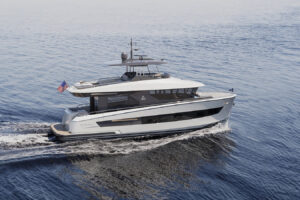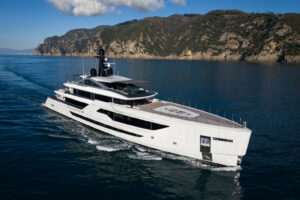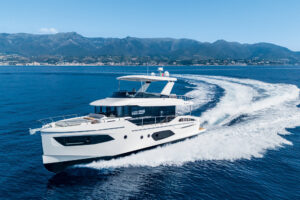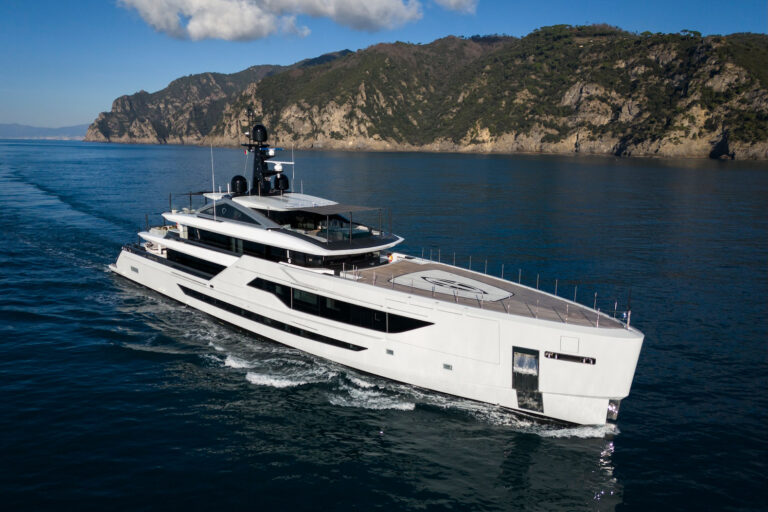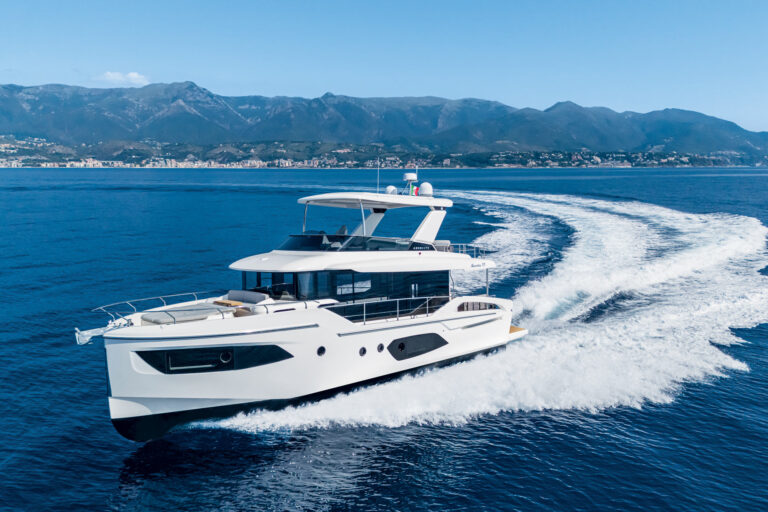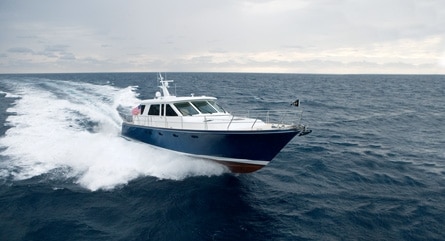
ytgjune08globarrw.jpg
After spending nearly four hours with Bruce Livingston, builder of the Global Arrow 68, I was completely devoid of energy. During the interview on board his latest build, I went through two pens, developed a nearly crippling writer’s cramp, and needed to dig into my briefcase for a second notebook to document the river of information rushing from Livingston’s mouth. And when I say river, think whitewater and rapids! Yet every word from this stocky, bull terrier of a boatbuilder was deliberate, precise, and meaningful. During our walkthrough, there were no flowery phrases overflowing with pointless platitudes. In fact, I never knew it was possible to communicate an entire train of thought without the use of adjectives. With Livingston, it was just the facts, nothing but the facts-perhaps a byproduct of having a Marine Corps colonel as a father. It became clear that this same no-fluff, straightforward approach was also instilled in the design and build of the Hunt-designed Global Arrow 68. I believe Livingston is incapable of operating in any other fashion. And this is what you want from your boatbuilder.
When we began talking about the genesis of the 68’s design, the benefits of this approach became clear. “It had to perform well first,” shot Livingston. “Then we concentrated on the profile and then the structure.” Perhaps this strategy may appear obvious to some, but the reality is that these basic, interwoven fundamentals are often not the foundation of a new yacht design. Instead, focus groups of weekend warriors and marketing gurus may sit around a table in a hotel conference center and begin a business school exercise that leads to product design. Results can sometimes yield to weighty demands such as four staterooms, a steam shower, a pool table, 40-knot cruising speed, a place for a hair dryer, and not an inch over 35 feet. However, concentrating on Livingston’s three key fundamentals- performance, profile, and structure-resulted in a new design that not only achieved these goals without compromise, but created a yacht that excels as an overall package.
The fact that Livingston and his partners made performance the first priority, made C. Raymond Hunt Associates the obvious choice as designers. Livingston and the Hunt staff have collaborated on previous projects, spawning a solid working foundation that carried over to the 68. The Hunt pedigree and ability to engineer lightweight, high performance models served the project well. Fully loaded, our test boat weighed in at approximately 119,000 pounds. “We’ll lose three to four thousand pounds on the next hulls,” volunteered Livingston. For weight control, the hull is fully cored with varying densities. A good portion of the boat is infused as well, reducing weight in these parts by 10 to 15 percent.
For the profile, Livingston and his partners collaborated with Hunt using an existing Hunt design as a starting point. The end result is a purposeful yet elegant design. She will be equally at home in full dress on commissioning weekend at the yacht club or anchored on the south side of Andros with a flats boat rigged for bonefishing trailing from her stern while the dive gear is piled on the swim platform. After reviewing the profile from various points on the dock, I realized there are no bad angles. If you look at the running shots within these pages, you’ll notice that classic and modern flow together effortlessly, whether viewed from the stern or bow. The teak caprail is not a necessary component of the hull-to-deck joint and the boat can be ordered without it. But I think it dresses the boat up just enough, without subsidizing your varnish guy’s new Range Rover.

| | |
A single door leads from the aft deck into the saloon. If this were my boat, I would try to alter the arrangement to allow for a more seamless transition between the saloon and aft deck. In all climates, a sheltered after deck that serves as an extension of the saloon area can only enhance your cruising experience. In addition to the model shown here, Global Yacht Builders offers a flybridge model that may appeal to buyers looking for this kind of additional outdoor living space.
Though I had seen the boat several times, when Livingston and I walked into the saloon early in the morning, I realized that it was the first time I had been on board when there wasn’t a crowd of people. In fact, Global Arrow had hosted a party of nearly 50 people, with caterers and servers flowing between the upper galley and the lower deck bar and office area with ease, the night before.

| | |
Our test boat featured an up-galley arrangement, which, in my opinion, was tough to beat. Livingston noted that they see the 68 at the upper end of the owner-operator market. Therefore, you’ll be able to converse easily between the galley and the adjacent helm. If you need to leave the dock early, your mate can be cooking up breakfast while you’re blazing a trail to your next secret cove. Abaft the Stidd helm seat is a double, forward-facing bench seat. This was a clever touch and will also allow your guests to keep you company as you’re cruising.
The 6-foot, 6-inch headroom and vast expanse of windows give the saloon the feeling of a much larger yacht. Sitting on one of the two sofas, I was able to see out easily. An overhead retractable sunroof brings in the fresh breezes and sun while underway. If the weather turns foul, don’t expect the sea to find its way into the saloon. Livingston ensured that the gutters and drainage system were sufficient to dump significant volume.
The need for performance also influenced the execution of the interior woodwork. In order to control the weight, all the woodwork is cored using a tri-cell honeycomb. When opening the doors, I was able to feel that each door was light as a feather.
The 68’s structure uses a system of three structural bulkheads, ten web-like structures rising from the bottom and tying in the hull sides, deck and coach roof, and five longitudinal stringers. “The interior is a completely unnecessary structural component of the boat,” says Livingston.
The fit and finish are flawless, as I would expect from Livingston, who built the venerable Ted Hood Little Harbor Series as well as Grand Banks. There was no plank-cut wood in the cherry interior and the builder did an excellent job of blending color and grains.
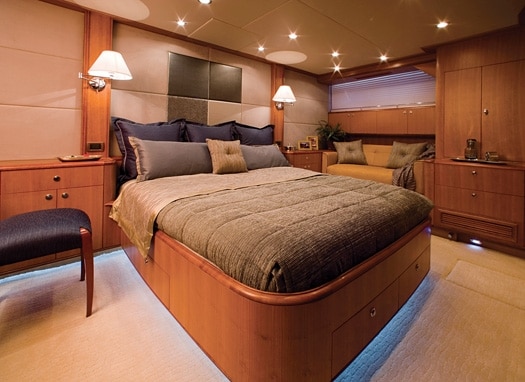
| | |
The interior layout features a full-beam master stateroom that rivals some 100-footers I’ve cruised on. There is a VIP stateroom forward and a second guest stateroom to starboard. Throughout the boat every available space is used for stowage. It would not be a problem to load up for a few months of down-island cruising on the 68.
The standing engineroom reflects this same level of fit and finish. The 1,550-horsepower Caterpillar C32 diesels are easily serviced on all sides. Two Northern Lights generators sit abaft the engines. Livingston is planning a few changes on future boats, as part of his quest to make each boat better. But I can say without hesitation, this engineroom was near perfect.
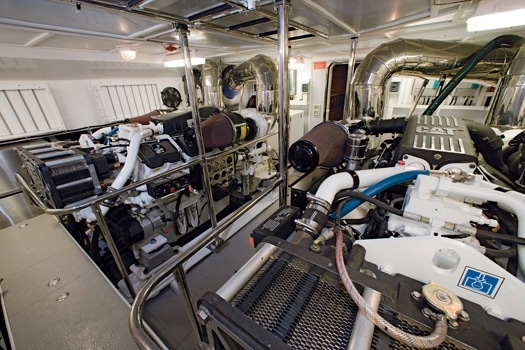
| | |
The crew quarters behind the engineroom is accessed either through the transom or deck hatch.The area can be ordered in several different congurations to accommodate an additional crew member or to serve as a larger utility room.
“Well, what do you think?” asked Livingston as we departed the crew quarters and stepped onto the dock to stare at his new darling. My brain was still fuzzy from the overload of facts and gures. Exhausted, I could only smile and give Livingston a pat on the back, realizing that despite these four hours, there was still so much more that went into the Global Arrow 68. Next time I would need to come back with reams of paper to record all these items. But one thing is for sure, when builders and designers concentrate on performance, prole, and structure, they’re sure to hit a bull’s eye.

